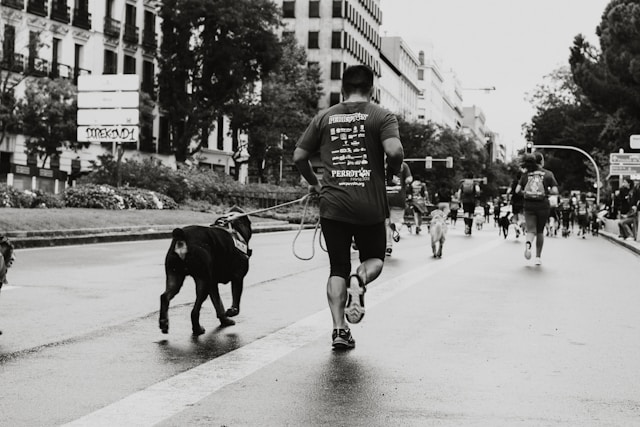Regular exercise is crucial for maintaining your dog’s overall health and well-being. Just like humans, dogs require physical activity to stay fit, mentally stimulated, and emotionally balanced. In this guide, we’ll explore the myriad benefits of regular exercise for dogs and provide a variety of fun activities and ideas to keep your furry friend engaged and active.
1. Health Benefits of Regular Exercise
1.1 Weight Management
- Prevention of Obesity: Regular physical activity helps regulate your dog’s weight by burning calories and building muscle. Obesity can lead to numerous health issues, including diabetes, heart disease, and joint problems.
- Maintaining a Healthy Weight: Exercise helps balance calorie intake with energy expenditure, ensuring your dog maintains a healthy weight and reduces the risk of weight-related illnesses.
1.2 Cardiovascular Health
- Improved Heart Health: Just like in humans, regular exercise strengthens the heart and improves circulation. This can help prevent heart disease and improve overall cardiovascular function.
- Enhanced Respiratory Function: Physical activity increases lung capacity and efficiency, benefiting your dog’s respiratory system.
1.3 Joint and Muscle Health
- Stronger Muscles and Joints: Exercise helps build and maintain strong muscles, which support and stabilize the joints. This is especially important for older dogs and breeds prone to joint issues.
- Prevention of Arthritis: Regular movement can help prevent stiffness and arthritis, keeping your dog agile and flexible.
1.4 Mental Stimulation
- Reduced Boredom: Exercise provides mental stimulation and helps alleviate boredom. Dogs that are physically active are less likely to engage in destructive behaviors caused by excess energy.
- Increased Cognitive Function: Engaging in varied activities helps keep your dog’s mind sharp and responsive, reducing the risk of cognitive decline as they age.
2. Fun Activities for Your Dog
2.1 Walks and Hikes
- Daily Walks: Regular walks are essential for maintaining your dog’s health. Aim for at least 30 minutes to an hour of walking each day, depending on your dog’s breed and energy level.
- Hiking Adventures: For more active dogs, hiking provides both physical exercise and mental stimulation. Exploring new trails and terrains can be an exciting adventure for your dog.
2.2 Fetch and Frisbee
- Playing Fetch: Fetch is a classic game that provides excellent physical exercise and helps reinforce training commands like “sit” and “drop it.” Use a ball or a toy to engage your dog in a fun, high-energy activity.
- Frisbee: Playing frisbee is another great way to exercise your dog. It involves running, jumping, and catching, which can be especially stimulating for high-energy breeds.
2.3 Agility Training
- Agility Courses: Setting up an agility course in your backyard or joining a local agility class can be a fantastic way to challenge your dog both physically and mentally. Agility training involves navigating obstacles like jumps, tunnels, and weave poles.
- DIY Obstacles: You can create a simple agility course at home using household items like broomsticks, hula hoops, and chairs to build a fun and engaging environment.
2.4 Interactive Toys and Puzzles
- Treat-Dispensing Toys: Toys that dispense treats as your dog plays with them can keep them engaged and mentally stimulated. These toys encourage problem-solving and physical activity.
- Puzzle Games: Interactive puzzles that require your dog to figure out how to access treats can provide both mental and physical exercise. These games challenge your dog’s intelligence and dexterity.
2.5 Dog Sports
- Flyball: Flyball is a competitive dog sport that involves running over hurdles to retrieve a ball. It’s a high-energy activity that promotes teamwork and agility.
- Dock Diving: Dock diving is a sport where dogs leap off a dock into a pool of water to retrieve a toy. It’s an excellent way to exercise and cool off, especially in warmer weather.
3. Safety Tips for Exercising Your Dog
3
3.1 Gradual Introduction
- Start Slowly: If your dog is new to exercise or hasn’t been active recently, gradually increase the intensity and duration of their activities. Sudden increases in exercise can lead to injuries or discomfort.
- Warm-Up and Cool Down: Just like humans, dogs benefit from a proper warm-up before vigorous exercise and a cool-down period afterward. Gentle stretching and walking can help prevent muscle strains and injuries.
3.2 Monitor Weather Conditions
- Heat Awareness: Be mindful of the weather conditions when exercising your dog. Avoid strenuous activities during extreme heat to prevent heatstroke. Early morning or late evening walks can be cooler and safer.
- Cold Weather Precautions: In cold weather, ensure your dog is protected from the elements. Shorter, more frequent walks and doggy sweaters or jackets can help keep them comfortable.
3.3 Hydration and Rest
- Provide Water: Always ensure your dog has access to fresh water before, during, and after exercise. Hydration is crucial, especially during intense physical activities.
- Rest Periods: Allow your dog adequate time to rest and recover after exercise. Over-exercising can lead to fatigue and increase the risk of injury.
3.4 Health Considerations
- Consult Your Vet: If your dog has any pre-existing health conditions or if you’re unsure about their exercise routine, consult your veterinarian. They can provide personalized advice and recommendations based on your dog’s specific needs.
4. Tailoring Exercise to Your Dog’s Breed and Age
4.1 Puppies
- Short Play Sessions: Puppies have boundless energy but also shorter attention spans. Engage them in short, frequent play sessions rather than long periods of exercise.
- Gentle Activities: Activities like gentle fetch and short walks are ideal for young puppies. Avoid high-impact exercises that could stress their developing joints.
4.2 Adult Dogs
- Varied Activities: Adult dogs benefit from a mix of exercise types, including walking, running, and interactive play. Tailor activities to their energy levels and preferences.
- Breed-Specific Needs: Consider your dog’s breed characteristics. High-energy breeds like Border Collies may require more intensive exercise, while lower-energy breeds might be satisfied with moderate activity.
4.3 Senior Dogs
- Low-Impact Exercises: Older dogs may require lower-impact activities to accommodate age-related changes. Gentle walks, swimming, and short play sessions can be effective and safer.
- Monitor for Signs of Discomfort: Pay attention to signs of discomfort or pain and adjust their exercise routine accordingly. Regular vet check-ups are also important to address any age-related health issues.
5. Benefits Beyond Physical Health
5.1 Strengthened Bond
- Quality Time: Exercise provides an opportunity for you and your dog to spend quality time together. This strengthens your bond and enhances your relationship.
- Trust Building: Engaging in activities together helps build trust and communication between you and your dog, creating a more harmonious relationship.
5.2 Behavior Management
- Reduced Anxiety: Regular exercise can help alleviate anxiety and stress in dogs by providing an outlet for excess energy and promoting relaxation.
- Improved Behavior: Well-exercised dogs are often better behaved and less likely to engage in destructive behaviors. Exercise helps regulate their mood and behavior.
5.3 Socialization Opportunities
- Meeting Other Dogs: Activities like group walks, dog parks, and training classes provide opportunities for your dog to socialize with other dogs and people.
- Exposure to New Environments: Regular outings expose your dog to various environments, sounds, and experiences, which helps them adapt to new situations and become more confident.
6. Incorporating Exercise into Your Routine
6.1 Setting a Schedule
- Daily Routine: Establish a consistent exercise routine that fits into your daily schedule. Consistency helps ensure that your dog receives regular physical activity.
- Flexible Planning: Adapt your exercise routine based on your dog’s needs and your schedule. Incorporate different types of activities to keep things interesting for both you and your dog.
6.2 Making Exercise Fun
- Variety: Introduce a variety of activities to keep exercise enjoyable for your dog. Changing up the routine helps maintain their interest and enthusiasm.
- Involvement: Engage in activities that you both enjoy. Your enthusiasm and involvement will make exercise more enjoyable and motivating for your dog.
Conclusion
Regular exercise is essential for your dog’s physical and mental well-being. By understanding the benefits and incorporating a variety of fun activities into your routine, you can help your dog stay healthy, happy, and engaged. Whether it’s a daily walk, a game of fetch, or participating in dog sports, exercise strengthens the bond between you and your dog while supporting their overall health. Make exercise a priority and enjoy the many rewards of a fit and happy canine companion. Happy exercising!











Leave a Reply